

Index > Society of the Atonement
| click
on the image below for the icon description and the biographies of Father Paul and of Mother Lurana |
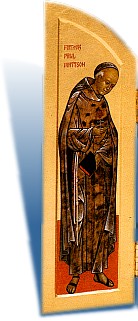 |
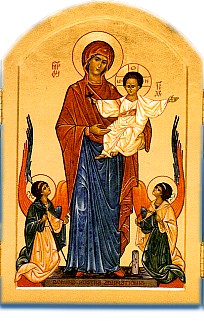 |
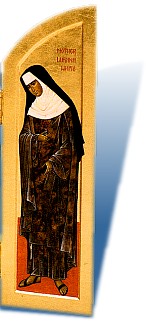 |
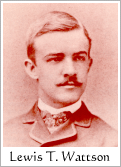
![]() n Sunday, July 9th, 1893, the Reverend Lewis T. Wattson, rector of St. John's Episcopal Church in Kingston, New York, opened his King James Bible for a special purpose. He hoped to find within its pages a name for the Religious Community that he strongly felt God was calling him to found. The thought of founding a Religious Community preoccupied his mind from boyhood. One day, his father, the Reverend Joseph Newton Wattson recounted to him the following incident, "I was present once," said the elder Wattson "in the Roman Catholic Cathedral of Baltimore, when Walworth, as a Paulist Father, addressed a vast concourse of men who packed the building to the doors. You see, Walworth and I were students together at the General Theological Seminary... What we need in the Episcopal Church is a preaching Order like the Paulists." Suddenly the ten year old boy heard an interior voice saying, "That is what you will do some day, found a preaching Order like the Paulists."
n Sunday, July 9th, 1893, the Reverend Lewis T. Wattson, rector of St. John's Episcopal Church in Kingston, New York, opened his King James Bible for a special purpose. He hoped to find within its pages a name for the Religious Community that he strongly felt God was calling him to found. The thought of founding a Religious Community preoccupied his mind from boyhood. One day, his father, the Reverend Joseph Newton Wattson recounted to him the following incident, "I was present once," said the elder Wattson "in the Roman Catholic Cathedral of Baltimore, when Walworth, as a Paulist Father, addressed a vast concourse of men who packed the building to the doors. You see, Walworth and I were students together at the General Theological Seminary... What we need in the Episcopal Church is a preaching Order like the Paulists." Suddenly the ten year old boy heard an interior voice saying, "That is what you will do some day, found a preaching Order like the Paulists."
On that July Sunday, 1893, Father Wattson found himself reading chapter five, verse eleven of St. Paul's Letter to the Romans, "And not only so, but we also joy in God, through Our Lord Jesus Christ, by whom we have now received the atonement." "Atonement," here is the name that he would give to his Community, a name that was linked to Christ's Passover to the Father. Years later he would write to Mother Lurana, Foundress of the Franciscan Sisters of the Atonement, "The moment my eyes rested upon the word ‘Atonement' it seemed to stand out from that sacred page with a distinctness all its own and it flashed upon me, as I believe from Heaven, that the Community God was preparing was to be called the Society of the Atonement."
Divided into syllables the word read "at-one-ment." The new Society, to be founded in the Episcopalian Church, would be committed to the ministry of "at-one-ment," that is, prayer and work for the reconciliation of Christians and their churches, making them at-one, thereby reflecting the gift of unity given by Christ to his church in the power of the Holy Spirit. Such was Father Wattson's mind in 1893, a time when ecumenical concerns were far from vital in the life and witness of most Christian churches.
Yet even then Christian unity was a vital concern for Father Wattson Based on the witness of Sacred Scripture, he knew that the unity of Christian Churches was in accord with the will of Christ. One of his favorite verses came from St. John's Gospel which read, "That all may be one as you, Father, are in me and I in you; I pray that they may be one in us, that the world may believe that you have sent me" (Jn. 17:21). From this prayer of Jesus and from his own daily prayer life, Father Wattson drew inspiration and hope for the future of his new Society. As far as he was concerned the members of the Society of the Atonement would both pray and work for the fulfillment of Jesus' prayer... "that all may be one ... so that the world may believe." Christian unity and Christian mission (that the world may believe) would go hand in hand, thus forming the two-fold goal of the Society of the Atonement.
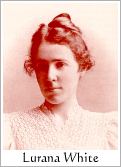
![]() lmost seven years would pass between Father Wattson's finding of the Atonement text in Paul's letter to the Romans and the foundation of the Society. And in God's providence it would be a woman's devout inquiry that would serve as the catalyst for the actual foundation of the Community. The woman was Miss Lurana White, a novice of the Episcopal Sisters of the Holy Child Jesus in Albany, New York. In the Spring of 1897, she wrote a letter to Father Wattson who was then Superior of a group of Episcopalian priests in Omaha, Nebraska. Her choice of Wattson arose, not because she knew him personally, but because she had heard that he was, in her own words, "very high church and had stood tenaciously for his ritualistic practices and Catholic teaching when Rector of Saint John's Church, Kingston, New York...." In her letter Miss White described her very strong desire to enter a religious Community whose members publicly professed the vow of poverty and lived according to the Franciscan spirit. Her inquiry of Father Wattson was simple: Did he know of any religious Community within the Episcopalian Church whose Rule required the public profession of the vow of poverty?
lmost seven years would pass between Father Wattson's finding of the Atonement text in Paul's letter to the Romans and the foundation of the Society. And in God's providence it would be a woman's devout inquiry that would serve as the catalyst for the actual foundation of the Community. The woman was Miss Lurana White, a novice of the Episcopal Sisters of the Holy Child Jesus in Albany, New York. In the Spring of 1897, she wrote a letter to Father Wattson who was then Superior of a group of Episcopalian priests in Omaha, Nebraska. Her choice of Wattson arose, not because she knew him personally, but because she had heard that he was, in her own words, "very high church and had stood tenaciously for his ritualistic practices and Catholic teaching when Rector of Saint John's Church, Kingston, New York...." In her letter Miss White described her very strong desire to enter a religious Community whose members publicly professed the vow of poverty and lived according to the Franciscan spirit. Her inquiry of Father Wattson was simple: Did he know of any religious Community within the Episcopalian Church whose Rule required the public profession of the vow of poverty?
In his response of May 31, 1897, Father Wattson stated, "I am sorry that I cannot give a satisfactory answer to your question. I am not sufficiently acquainted with the Rule of the several Sisterhoods in the Church to tell you whether any of them practice strict corporate poverty. If there be such I am not aware of it. Yet I have no doubt that a goodly percentage of them have no endowment and live practically by faith."
White's inquiry and Wattson's response marked the beginning of a long correspondence by means of which each shared what they believed was placed in their hearts by divine inspiration. Letter after letter provided the forum in which Father Wattson told of his dream to found a religious Community called the Society of the Atonement, dedicated to Christian unity and mission. Miss White described her love for St. Francis of Assisi and her compelling desire to live a life of vowed poverty. Gradually they experienced what she would later term "the one-ness of God's call," a one-ness that would include the vision of beginning together the new Society within the Episcopalian Church.
![]() t was in October 1898, that the Reverend Lewis Wattson and Lurana White met face-to-face for the first time. The place of their meeting was the White family home located in Warwick, New York She described this meeting as follows,
t was in October 1898, that the Reverend Lewis Wattson and Lurana White met face-to-face for the first time. The place of their meeting was the White family home located in Warwick, New York She described this meeting as follows,
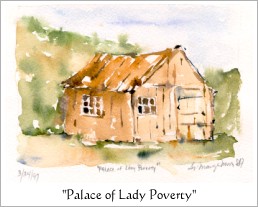
Our Father arrived in Warwick toward evening on October 3rd, the Eve of St. Francis Day. On that memorable day we met for the first time, The future Father Founder told the story of his call and of his hopes and I told him of my search for St. Francis and Corporate Poverty. Then there came to us both the dawning realization of the oneness of God's call.
On October 7th, at the conclusion of a three day retreat, Father Wattson and Lurana White made a "covenant" with God and with one another to found the Society of the Atonement. Each gave to the other a crucifix which in Lurana's words, "represented the entire oblation of ourselves into the hands of God for the purpose of founding the Society of the Atonement."
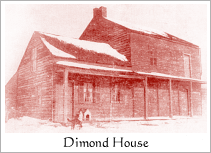 But where to begin? Should the new Community be founded in the far West, the mid West, or in one of the big cities of the East? Lurana suggested a site not too far from the small town of Garrison, New York, which friends had told her contained a "little abandoned church." If Francis of Assisi had begun his vocation after hearing the words, "Now, go hence, Francis, and build up my church, for it is nearly falling down," how fitting that the new Society begin its foundation near St. John's-in-the-Wilderness, the little abandoned church situated in an area called Graymoor. And so it happened. On December 15th, 1898, Lurana White took up residence near the church in a poor, windswept and dilapidated farmhouse called the "Dimond House."
But where to begin? Should the new Community be founded in the far West, the mid West, or in one of the big cities of the East? Lurana suggested a site not too far from the small town of Garrison, New York, which friends had told her contained a "little abandoned church." If Francis of Assisi had begun his vocation after hearing the words, "Now, go hence, Francis, and build up my church, for it is nearly falling down," how fitting that the new Society begin its foundation near St. John's-in-the-Wilderness, the little abandoned church situated in an area called Graymoor. And so it happened. On December 15th, 1898, Lurana White took up residence near the church in a poor, windswept and dilapidated farmhouse called the "Dimond House."
December 15th is now celebrated by the Sisters and Friars of the Atonement as Foundation Day. Late the following year, after completing some ten months of training for the religious life with the Episcopal Order of the Holy Cross, Father Wattson also went to Graymoor where he lived in an old paint shack which he called his "Palace of Lady Poverty."
![]() ather Wattson made his profession of vows and took the name Paul; White also took vows but retained her birth name, Lurana. They now set about the task of reflecting upon and clarifying the purpose of their new Society. Clearly their church unity vocation was founded on the prayer of Jesus, "That all may be one But this conviction would be shaped in a special way by both their understanding of church and by their pro-Roman beliefs. For Father Paul and Mother Lurana the one Church of Christ was constituted of the Roman Catholic Church, the Anglican Communion, and The Orthodox Church. Each was truly church and while each branch was a manifestation of Christ's one church, both the Anglican Communion and The Orthodox Church had suffered because of their break with the See of Rome. Indeed for Father Paul and Mother Lurana the Roman See was the divinely established center of Church unity.
ather Wattson made his profession of vows and took the name Paul; White also took vows but retained her birth name, Lurana. They now set about the task of reflecting upon and clarifying the purpose of their new Society. Clearly their church unity vocation was founded on the prayer of Jesus, "That all may be one But this conviction would be shaped in a special way by both their understanding of church and by their pro-Roman beliefs. For Father Paul and Mother Lurana the one Church of Christ was constituted of the Roman Catholic Church, the Anglican Communion, and The Orthodox Church. Each was truly church and while each branch was a manifestation of Christ's one church, both the Anglican Communion and The Orthodox Church had suffered because of their break with the See of Rome. Indeed for Father Paul and Mother Lurana the Roman See was the divinely established center of Church unity.
But dominating their prayer and thoughts was their own beloved Anglican Communion. Christ's gift of unity would be rendered much more visible if the Anglican Church would reunite as a body with the Church of Rome. More and more this concern for the corporate reunion of the Anglican Communion with Rome occupied the prayer and energies of the new Founders. There were other Episcopalians, both in the United States and abroad, who shared this pro-Roman view. But should a Franciscan community, newly founded in the Episcopal Church, become the voice for proclaiming that there could be no real Church Unity except that which was centered around the Chair of Peter?
![]() n early October, 1900, Mother Lurana forcefully expressed to Father Paul the hazards of such an enterprise: "Do you realize to what persecutions, ostracism, and peril of annihilation you will be exposing the Society of the Atonement by undertaking such a propaganda? "‘ But true to what she had called the "one-ness of God's call, "she made her own Father Paul's response, "Yes, I think I do. Nevertheless if our witness is from God, sooner or later it will prevail though the whole world be against us."
n early October, 1900, Mother Lurana forcefully expressed to Father Paul the hazards of such an enterprise: "Do you realize to what persecutions, ostracism, and peril of annihilation you will be exposing the Society of the Atonement by undertaking such a propaganda? "‘ But true to what she had called the "one-ness of God's call, "she made her own Father Paul's response, "Yes, I think I do. Nevertheless if our witness is from God, sooner or later it will prevail though the whole world be against us."
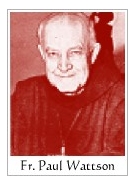
And so in a sermon preached at Graymoor on October 28, 1900, Father Paul contended that the faith, once and for all delivered to the saints, was none other than the faith of the Holy Roman Catholic Church. Much to the surprise of the small congregation that day, he likewise affirmed that the Chair of Peter was the divinely constituted center of a reunited Christendom. Other "Roman beliefs" that rested easy with both Founders were the doctrines of papal infallibility, the de jure divino universal jurisdiction of Peter's successor and the Immaculate Conception of Mary. On the other hand both Father Paul and Mother Lurana were convinced that the 1896 teaching of Pope Leo XIII, contained in Apostolicae Curae regarding the validity of Anglican orders, was not irrevocable and would in fact be changed as new theological and historical data came to light.
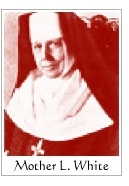
It was their enthusiastic promotion of Roman beliefs, intertwined with an uncritical exaltation of the Papacy as the Center of Church Unity, that brought many of their fellow Episcopalians, clergy and lay, to look with suspicion upon this new religious Community. Gradually more and more pulpits within the Episcopalian Church were closed to Father Paul. Donations, much needed by the fledgling Community, dwindled to almost nothing. The sentiments surfacing ever more forcibly against the new Founders were expressed most clearly in the closing lines of an editorial of the Living Church, October 5, 1901, a publication held in high esteem by many Episcopalians, "The whole Anglican communion is unanimous in repudiating absolutely the doctrine of Papal Supremacy, which the earnest but erratic priest of Graymoor has preached. "
![]()
 n an attempt to find an audience who would listen to his message of Christian Unity, Father Paul, in collaboration with Mother Lurana, began a monthly magazine called The Lamp. At the insistence of Mother Lurana, the top of each page bore the inscription, "Ut Omnes Unum Sint." (That All May Be One). In the first issue of February 1903, Father Paul stated the purpose of the new magazine as follows:
n an attempt to find an audience who would listen to his message of Christian Unity, Father Paul, in collaboration with Mother Lurana, began a monthly magazine called The Lamp. At the insistence of Mother Lurana, the top of each page bore the inscription, "Ut Omnes Unum Sint." (That All May Be One). In the first issue of February 1903, Father Paul stated the purpose of the new magazine as follows:
Candlemas... marks the first appearance of The Lamp. We have lighted it as witness to the Old Faith as taught by the English Church before a wicked King severed her from the Center of Unity. We believe that not only does our Blessed Lord wish us to pray, but to work for Unity; and instead of magnifying differences between ourselves and Rome, we ought to minimize them and thus prepare the way for the peace which we all long for as Christians.
Now that pulpits were closed to him, Father Paul had in The Lamp a new medium, but his message remained basically the same. And it was a message shared by other pro-Romans within the Anglican Communion during the opening years of the twentieth century. The pages of The Lamp in those early years unfolded this message, constantly addressing the issue of the corporate reunion of the Anglican Communion with Rome, upholding the Roman Catholic teaching on the Pope as successor to Peter, maintaining the validity of Anglican Orders and tirelessly pointing to the Chair of Peter as the visible center of Church Unity.
In the minds of most readers of The Lamp, the Co-founders of the Society of the Atonement were definitely heading in the direction of Rome. Yet between late 1900, when both publicly proclaimed that Church Unity was impossible without reunion with the See of Rome, until the year 1907, neither felt personally driven to seek entrance into the Roman Church. Their common mind was that corporate reunion with Rome was the goal, the desideratum, even if the "corpus" was only constituted of a remnant of "Anglo-Catholics" or "Pro-Roman" members within the Anglican Communion. In the April 1903 issue of The Lamp Father Paul expressed it in this way, "But when those who have fallen away from Catholic Unity return to the sheep-fold of Peter, they will return as a body. They went out as a body and they will return as a body."
![]() his firm conviction concerning corporate reunion was considerably weakened in October of 1907, when the General Convention of the Episcopal Church voted to allow ministers, not ordained in their Church, to occasionally preach from pulpits of Episcopalian Churches. Such preaching required the permission of the Congregation's Rector or, in his absence, the permission of the Bishop. Referred to as the Open Pulpit Canon, it called into question in the minds of both Father Paul and Mother Lurana their life-long belief that the Anglican Communion was, as a body, a distinct branch of the one true Church of Christ. Now it seemed that the uniqueness, as well as the ecclesial equality of the Anglican Communion with the Roman and the Orthodox Church, were being abandoned in and through the General Convention's decision to allow ministers from other churches to preach from the pulpits of the Episcopal Church.
his firm conviction concerning corporate reunion was considerably weakened in October of 1907, when the General Convention of the Episcopal Church voted to allow ministers, not ordained in their Church, to occasionally preach from pulpits of Episcopalian Churches. Such preaching required the permission of the Congregation's Rector or, in his absence, the permission of the Bishop. Referred to as the Open Pulpit Canon, it called into question in the minds of both Father Paul and Mother Lurana their life-long belief that the Anglican Communion was, as a body, a distinct branch of the one true Church of Christ. Now it seemed that the uniqueness, as well as the ecclesial equality of the Anglican Communion with the Roman and the Orthodox Church, were being abandoned in and through the General Convention's decision to allow ministers from other churches to preach from the pulpits of the Episcopal Church.
Should they not make overtures to Catholic authorities and see if they and their  small Community might not be received corporately into the Roman Catholic Church? Mother Lurana took the initiative by obtaining a meeting with Archbishop John Farley of New York on November 21, 1907. Her comment concerning that meeting was, "I found him a conservative of conservatives." "The future Cardinal offered little encouragement relative to the corporate reception of the Society of the Atonement into the Catholic Church. There simply was no precedent for this kind of reception. But there was ample precedent for individuals coming from this or that Protestant Church and embracing the fullness of the Catholic faith. And so Mother Lurana was left with the impression that she was welcome to enter the Catholic Church and live as a vowed Religious by seeking admission into one of the many Sisterhood Communities already existing within that Church. The same would logically apply in the case of Father Paul. He could seek admission into the Jesuits or Redemptorists or Passionists or Franciscans, stable Communities that had already given ample proof of holiness and Gospel witness within the Catholic Church. As far as the Archbishop was concerned individual entrance into the Catholic Church on the part of Father Paul, Mother Lurana, and their few followers was absolutely necessary. He was not in favor of the reception of the Society as such and its continuation in the Catholic Church as a distinct Religious Community.
small Community might not be received corporately into the Roman Catholic Church? Mother Lurana took the initiative by obtaining a meeting with Archbishop John Farley of New York on November 21, 1907. Her comment concerning that meeting was, "I found him a conservative of conservatives." "The future Cardinal offered little encouragement relative to the corporate reception of the Society of the Atonement into the Catholic Church. There simply was no precedent for this kind of reception. But there was ample precedent for individuals coming from this or that Protestant Church and embracing the fullness of the Catholic faith. And so Mother Lurana was left with the impression that she was welcome to enter the Catholic Church and live as a vowed Religious by seeking admission into one of the many Sisterhood Communities already existing within that Church. The same would logically apply in the case of Father Paul. He could seek admission into the Jesuits or Redemptorists or Passionists or Franciscans, stable Communities that had already given ample proof of holiness and Gospel witness within the Catholic Church. As far as the Archbishop was concerned individual entrance into the Catholic Church on the part of Father Paul, Mother Lurana, and their few followers was absolutely necessary. He was not in favor of the reception of the Society as such and its continuation in the Catholic Church as a distinct Religious Community.
For his part Father Paul, while dismayed by the passage of the Open Pulpit Canon, continued to work within the Episcopal Church for the goal of Christian unity as he understood it. In 1907, he co-authored together with an English pro-Roman advocate, the Reverend Spencer Jones, a book called The Prince of the Apostles. Mother Lurana wrote the first chapter and edited the other chapters. Again the See of Peter was singled out as the visible center of Christian unity.
Father Vincent McNabb, a well known English Dominican pointed this out in his review of the book, "...The most important fact is not what is said but who have said it...and if we may be allowed the phrase, we find the title page the weightiest page in the book."
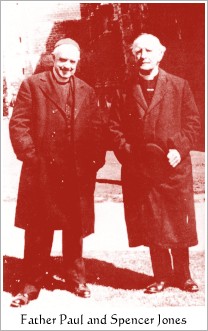
![]() t was likewise between the 1907 passage of the Open Pulpit Canon and the entrance of the Society into the Catholic Church in1909, that Father Paul began what would be one of his most enduring apostolates, the Church Unity Octave. His English friend, Spencer Jones, suggested that be an annual one day of prayer and preaching on the office of the papacy. He mentioned that June 29, the feast of St. Peter, would be a very appropriate day for this devotion. Replying to the Reverend Jones on November 30, 1907, Father Paul wrote, "The ‘Peter sermon' suggestion is fine.... In addition to that, what do you think of inaugurating a Church Unity Week beginning with St. Peter's Chair at Rome, January 18th, and ending with St. Paul's Day?" Without waiting for an answer from Jones, Father Paul began writing letters to clergy and friends of Graymoor, both Roman and Episcopal, asking them to participate in the Octave of Prayer for Unity. Over 2,000 persons agreed to do so in this first observance. At the end of a report in The Lamp concerning the Franciscan Friars and Sisters of 1908 observance, Father Paul expressed the hope that, "this Church Unity observance so auspiciously begun, may be kept with increasing numbers year after year until our Lord's prayer, Ut omnes unum sint is completely fulfilled." Little did Father Paul and Mother Lurana dream that the Week of Prayer for Christian Unity would one day be observed almost universally by the major Christian Churches.
t was likewise between the 1907 passage of the Open Pulpit Canon and the entrance of the Society into the Catholic Church in1909, that Father Paul began what would be one of his most enduring apostolates, the Church Unity Octave. His English friend, Spencer Jones, suggested that be an annual one day of prayer and preaching on the office of the papacy. He mentioned that June 29, the feast of St. Peter, would be a very appropriate day for this devotion. Replying to the Reverend Jones on November 30, 1907, Father Paul wrote, "The ‘Peter sermon' suggestion is fine.... In addition to that, what do you think of inaugurating a Church Unity Week beginning with St. Peter's Chair at Rome, January 18th, and ending with St. Paul's Day?" Without waiting for an answer from Jones, Father Paul began writing letters to clergy and friends of Graymoor, both Roman and Episcopal, asking them to participate in the Octave of Prayer for Unity. Over 2,000 persons agreed to do so in this first observance. At the end of a report in The Lamp concerning the Franciscan Friars and Sisters of 1908 observance, Father Paul expressed the hope that, "this Church Unity observance so auspiciously begun, may be kept with increasing numbers year after year until our Lord's prayer, Ut omnes unum sint is completely fulfilled." Little did Father Paul and Mother Lurana dream that the Week of Prayer for Christian Unity would one day be observed almost universally by the major Christian Churches.
![]() n the pages of The Lamp, in countless letters, and in private conversations Father Paul had tenaciously held to the twofold witness of the Primacy of the Holy See and the Validity of Anglican Orders. Throughout the early 1900s many were the voices that spoke to him concerning the inconsistency of this position. For example, Father Paul himself cites two such witnesses in the June, 1903 issue of The Lamp: "A distinguished Jesuit Father, in the Sacred Heart Messenger exclaims, ‘How any one can pretend to obey the Pope and remain an Anglican is more than we can understand.'" And from the pen of an Episcopal clergyman, "Your position is absolutely untenable. It is neither Anglican or Roman, and I am positive, therefore, that it cannot be Catholic."
n the pages of The Lamp, in countless letters, and in private conversations Father Paul had tenaciously held to the twofold witness of the Primacy of the Holy See and the Validity of Anglican Orders. Throughout the early 1900s many were the voices that spoke to him concerning the inconsistency of this position. For example, Father Paul himself cites two such witnesses in the June, 1903 issue of The Lamp: "A distinguished Jesuit Father, in the Sacred Heart Messenger exclaims, ‘How any one can pretend to obey the Pope and remain an Anglican is more than we can understand.'" And from the pen of an Episcopal clergyman, "Your position is absolutely untenable. It is neither Anglican or Roman, and I am positive, therefore, that it cannot be Catholic."
But it was only in 1909 that Father Paul and Mother Lurana came to see that their position was "absolutely untenable. " In May of that year, Bishop Frederick Joseph Kinsman of Delaware, who had recently become the Episcopal Visitor for the Society of the Atonement, met with Father Paul so that he could hear first hand about the Society's allegiance to both the Roman Catholic Church and the Anglican Communion. Two months later, in a letter addressed to Father Paul and dated July 5, 1909, Bishop Kinsman provided the final stimulus that moved Father Paul and Mother Lurana to seek entrance into the Catholic Church. In that momentous letter, after describing most accurately the tenets embraced by the Co-founders Bishop Kinsman wrote,
My advice is that, in the interest of single-minded honesty and devotion to duty, you make the choice between the two Churches. You cannot serve either the Papal Church or the Protestant Episcopal Church well if you try to serve both at the same time. Either give up belief in a divinely established Papacy and in Roman dogmas as the one complete expression of the Christian faith, as one must do who is a consistent and contented Anglican; or else give up Anglican Orders, make an unqualified submission to the Latin Church, and be a good Roman Catholic. I have no hesitation in saying that if I were in your position I should choose the latter alternative....
![]()
 n October 30, 1909, the Society of the Atonement acted upon the advice given by the Episcopal Bishop of Delaware. On that day, Father Paul and Mother Lurana, along with another Friar, two Atonement Sisters, two novices, and ten lay associates made their unqualified submission to the Latin Church. Their profession of faith was received by Monsignor Joseph Conroy, Vicar General of the diocese of Ogdensburg, who was the personal representative of Archbishop John Farley.
n October 30, 1909, the Society of the Atonement acted upon the advice given by the Episcopal Bishop of Delaware. On that day, Father Paul and Mother Lurana, along with another Friar, two Atonement Sisters, two novices, and ten lay associates made their unqualified submission to the Latin Church. Their profession of faith was received by Monsignor Joseph Conroy, Vicar General of the diocese of Ogdensburg, who was the personal representative of Archbishop John Farley.
Due to the influence of Cardinal Merry del Val who was a faithful reader of The Lamp, and Secretary of State under Plus X, the Holy See was quite gracious in its reception of the small Community. It was accepted as a distinct Religious Community, allowed to keep its name, and encouraged to keep as its purpose prayer and work for Christian unity and mission. The corporate reception of the Friars and Sisters of the Atonement into the Roman Church was the first such occurrence since the Reformation.
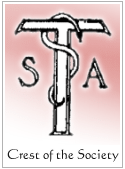
![]() any of the ministries which had already begun when the Society was in the Episcopal Church continued to grow as it adapted itself to life within the Roman Church. The Lamp continued to highlight the message of Christian Unity, winning more and more people to its readership. The Union-That Nothing-Be-Lost, an organization which provided money for needy missionaries, grew larger and sensitized many to the apostolic labors of those men and women engaged in foreign and home missionary work. St. Christopher's Inn, an expression of the Society's commitment to Franciscan ideals, continued to receive thousands of homeless men each year, providing them with hospitality in the spirit of St. Francis. Among Roman Catholics, the Church Unity Octave, later known as the Week of Prayer for Christian Unity, was vigorously promoted every year from January 18 to 25.
any of the ministries which had already begun when the Society was in the Episcopal Church continued to grow as it adapted itself to life within the Roman Church. The Lamp continued to highlight the message of Christian Unity, winning more and more people to its readership. The Union-That Nothing-Be-Lost, an organization which provided money for needy missionaries, grew larger and sensitized many to the apostolic labors of those men and women engaged in foreign and home missionary work. St. Christopher's Inn, an expression of the Society's commitment to Franciscan ideals, continued to receive thousands of homeless men each year, providing them with hospitality in the spirit of St. Francis. Among Roman Catholics, the Church Unity Octave, later known as the Week of Prayer for Christian Unity, was vigorously promoted every year from January 18 to 25.
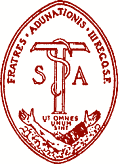 Captured by the founders' vision of Christian unity and mission many young men and women came to swell the ranks of the Friars and Sisters. Soon they had spread far and wide outside the United States to Canada, Italy, England, Ireland, Japan and Brazil. By 1935 when Mother Lurana died, the Society of the Atonement was known internationally throughout the Roman Catholic Church. Five years later in 1940, Father Paul's earthly pilgrimage ended. But his and Mother Lurana's dream and prayer for Christian Unity endured, was extended and refined by others from all Christian Churches, who, guided by the Spirit, gave renewed emphasis to the need for full and visible unity among all of Christ's followers.
Captured by the founders' vision of Christian unity and mission many young men and women came to swell the ranks of the Friars and Sisters. Soon they had spread far and wide outside the United States to Canada, Italy, England, Ireland, Japan and Brazil. By 1935 when Mother Lurana died, the Society of the Atonement was known internationally throughout the Roman Catholic Church. Five years later in 1940, Father Paul's earthly pilgrimage ended. But his and Mother Lurana's dream and prayer for Christian Unity endured, was extended and refined by others from all Christian Churches, who, guided by the Spirit, gave renewed emphasis to the need for full and visible unity among all of Christ's followers.
Today the Franciscan Friars and Sisters of the Atonement are engaged in diverse ministries on behalf of Christian unity and mission throughout the world. Each year they continue to promote the Week of Prayer for Christian Unity and encourage Christians to pray daily throughout the year for God's gift of unity. To raise ecumenical consciousness and foster Christian renewal, the Friars conduct ecumenical centers and libraries in Rome, Italy, and London, England. The Graymoor Ecumenical and Interreligious Institute (GEII), comprised of Friars, Sisters, and laity collaborates through its New York office with various departments of the National Council of Christian Churches and promotes dialogue and meetings with members of other faith traditions.
Through its Graymoor office the GEII publishes the monthly magazine, Ecumenical Trends, and provides for the printing and dissemination of all materials needed for the annual Week of Prayer for Christian Unity. Likewise at Graymoor the well-known Christian Unity Center welcomes people of all faiths for retreats, days of recollection, and ecumenical meetings. In connection with this Unity Center the Friars' DO NOT FEAR TO HOPE support group sponsors two annual retreats for persons with HIV/AIDS and provides as well weekly pastoral and spiritual guidance for their well-being.
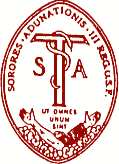 Friars of the Atonement serve as ecumenical officers in various dioceses of the United States, Canada and England, helping to make the goal of full and visible unity a vital concern among all Christians in those places. And while serving in parishes in these countries, as well as in Japan, they keep alive Jesus' prayer, enthusiastically embraced by Father Paul and Mother Lurana, "That all may be one ... that the world may believe."
Friars of the Atonement serve as ecumenical officers in various dioceses of the United States, Canada and England, helping to make the goal of full and visible unity a vital concern among all Christians in those places. And while serving in parishes in these countries, as well as in Japan, they keep alive Jesus' prayer, enthusiastically embraced by Father Paul and Mother Lurana, "That all may be one ... that the world may believe."
Faithful to the ecumenical and missionary vision of their Founders, especially that of Mother Lurana, who wanted her Sisters "to have many foundations, small and poor, but rich in Love," the Franciscan Sisters of the Atonement continue to promote the vision of Christian unity for the sake of Christian mission wherever they minister.
They are actively engaged in pastoral, social, and community development ministries in the United States, East and West, where they work in both diocesan and parish settings. In New York city and in Boston they operate Day Care Centers. At Graymoor and in Washington, DC, they conduct Retreat Houses.
In Vancouver, Canada, they minister to alleviate the sufferings of the poor, the hungry, the homeless, and the addicted. Several Sisters are also engaged in parish ministry in British Columbia. In Edmonton, Alberta, they operate Lurana Shelter, a haven for women and children who are victims of family violence; in Edmonton, too, they conduct a Head Start program for disadvantaged children in the inner city.
In Yokohama, Japan, they are responsible for kindergarten work and engage in pastoral ministry and other varied missionary activities. In Italy they conduct Retreat and Guest Houses for the many pilgrims to Rome and Assisi. In Ireland, too, they maintain a Retreat and Guest House and engage in other local pastoral activities. In all of this the Sisters of the Atonement continue to be guided by the teaching of their Foundress, "Our special missionary vocation grows directly out of our Unity vocation."
This centenary celebration of the foundation of the Society of the Atonement is in a special way a celebration of thanksgiving. Thanksgiving to God for raising up Father Paul and Mother Lurana and providing them with the grace to found a Community dedicated to the cause of Christian unity and mission. There is a definite sense of gratitude also, because so many Christians today together with their Churches, like Father Paul and Mother Lurana before them, have come to see the call to Christian unity as a Gospel imperative. Not without reason has our century been called "the age of ecumenism." Such a description of the era in which they lived never entered the minds and hearts of Mother Lurana and Father Paul. What did enter and permeate their lives and work was the need of prayer for Christian Unity. In their personal lives and in their witness to others, they embodied what Vatican II would later call "spiritual ecumenism." In the words of this Council's Decree on Ecumenism,
This change of heart and holiness of life, along with public and private prayer for the unity of Christians, should be regarded as the soul of the whole ecumenical movement, and merits the name, "spiritual ecumenism."
Without fully realizing it, Father Paul and Mother Lurana were among those who made visible the soul of the ecumenical movement, thereby leaving to their spiritual sons and daughters and many others a profound and precious legacy. And so wherever they may minister, the Franciscan Friars and Sisters of the Atonement continue to model their lives and their witness on Jesus' prayer "that all may be one ... that the world may believe." They know that real joy is found in His Atonement and in the spirit of St. Francis of Assisi as these were embraced by their Founders. With them, they can repeat St. Paul's words,
"WE JOY IN GOD
THROUGH OUR LORD JESUS CHRIST
BY WHOM WE HAVE NOW RECEIVED
THE ATONEMENT."
[Text taken from Franciscan Friars and Sisters of the Atonement Centennial]
Index | Centro Activities | Course | Publications | Conferences
Week of Prayer | Library
| Interconfessional Dialogues
Directory of Ecumenical Study Centers | Society of the Atonement
Guest Book | Credits | Site Map
Remarks to Webmaster at webmaster@pro.urbe.it